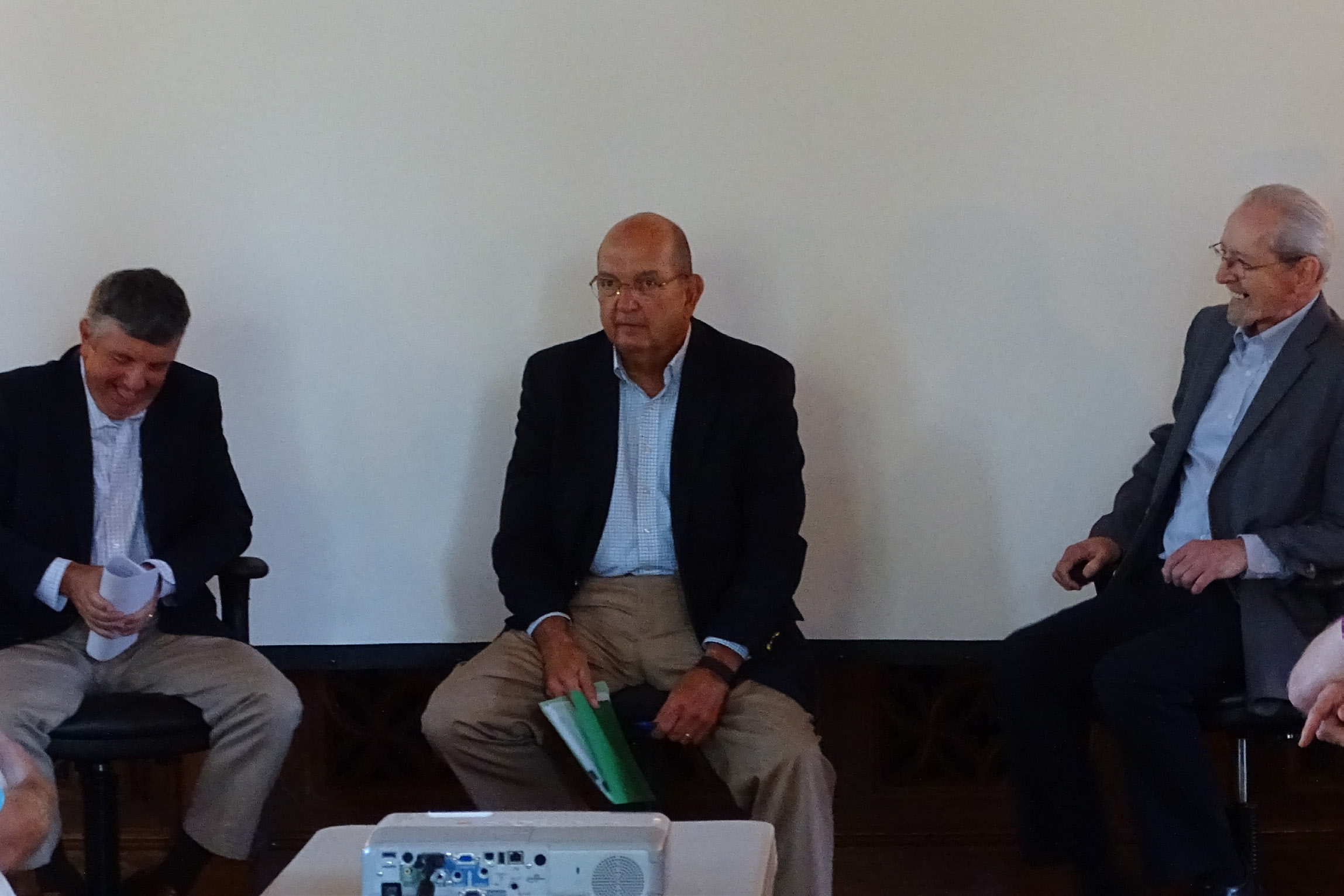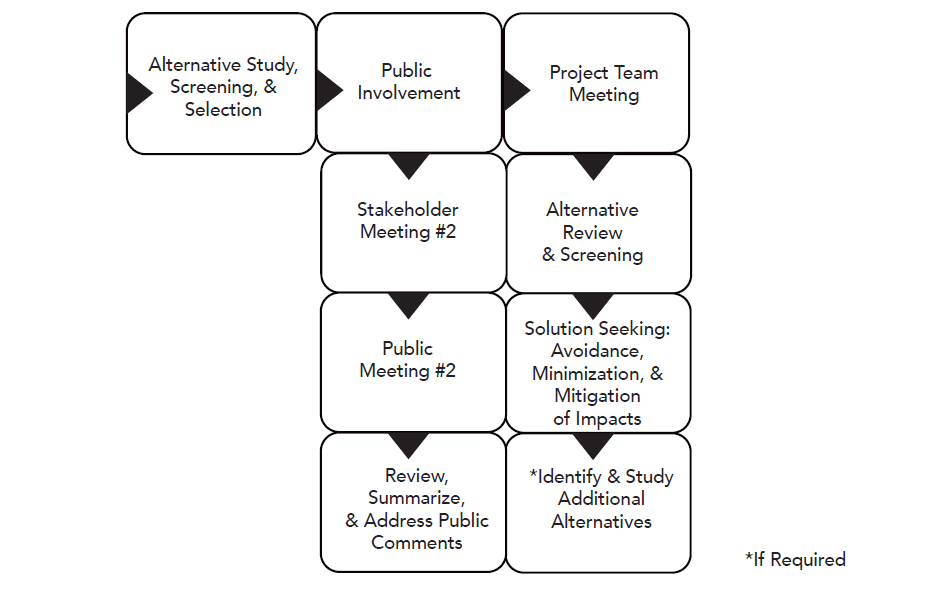Search for articles or browse our knowledge portal by topic.
Alternative Study, Screening, & Selection

Contents
1. Alternative Study, Screening, and Selection
3. Stakeholder Meeting #2 & Public Meeting #2
4. Review, Summarize, & Address Public Comments
5. Project Team Meeting and Alternative Review
6. Identify and Study Additional Alternatives (If Required)
7. Solution Seeking: Avoidance, Minimization & Mitigation of Impacts
The study, screening, and selection of alternatives can require the PM and PDT to undertake significant investigation and analysis to identify a reasonable range of legitimate, competitive alternatives that meet a project’s Purpose and Need. The range of alternatives must include at least one option that meets the scope, budget, and timeline of the Highway Plan. To meet the purpose and need and qualify as a reasonable and competitive alternative, concepts should be developed with attention to engineering and fiscal constraints. Alternatives should also fulfill the operational, safety, and other performance goals outlined in the Purpose and Need statement.
Study and screening are used to refine alternatives and produce a list of constructible, practical, and feasible options that fulfill the Purpose and Need. The study area and preliminary project costs should be defined for each alternative. While a preferred alternative may stand out, the PDT should not make a recommendation until all alternatives have been adequately explored and the impacts and issues surrounding each are understood. As the review process of alternatives progresses, SMEs continue to evaluate alternatives which remain under consideration, and work with the PM and PDT to eliminate those which no longer seem reasonable.
As a rule, if an alternative does not satisfy the Purpose and Need for the project, it should not be included in the analysis as an apparent and reasonable alternative. There are times when an alternative that is not reasonable is included (e.g., when another agency requests inclusion due to public expectation). In such cases, it should be clearly explained why the alternative is not reasonable (or prudent or practicable), why it is being analyzed in detail, and why it will not be selected. Among the alternatives, there must be one no-build alternative and another whose project estimate is at or below the approved Highway Plan budget.
The output from the alternative study and screening phase may include the draft environmental document (e.g., EA or CE), preliminary alternative plans (including temporary traffic control measures and possible detours), anticipated alternative performance, ROW and utility impacts with associated costs, possible mitigation measures, and corresponding project costs and schedule impacts.
Studying and screening alternatives helps the PM and PDT select a preferred alternative based on environmental, economic, engineering issues, anticipated performance, and public input. Alternative selection is the final key decision point of shared transportation decision making in a project’s conceptual stage. The final environmental document is then prepared, reviewed, and approved. The output is the approved environmental document and the selected alternative, which progresses to final design. The Highway Design Guidance Manual (HD- 203.3) summarizes issues to consider when developing alternatives.
A main objective of public hearings or meetings during the latter stages of project development is to let community members examine, review, and comment on the details of preferred alternatives. The opinions voiced at late-stage meetings are important considerations when selecting an alternative. Public meetings at this juncture are also used to discuss how issues or concerns brought up at a previous meeting can be resolved, particularly challenges related to environmental commitments.
Once the PDT has developed a reasonable number of feasible and competitive alternatives and understands the potential impacts of each, it may be appropriate to hold another public meeting or stakeholder meeting to present those alternatives and gather public/stakeholder opinion. This meeting may be held before or after identifying a preferred alternative.
Stakeholder engagement helps the PM and PDT better understand conditions in the project area. Members of stakeholder groups may come from a variety of backgrounds (e.g., local officials, emergency services, school transportation and/or administration, utility owners impacted). The composition of stakeholder groups should be tailored to address the needs and context of each project. Often stakeholder groups continue to meet periodically to receive updates and project-related information from the PDT. If the PDT decides more direct involvement with stakeholders is needed, the PDT may engage a subset of the stakeholder group through a focus group.
For more information on public meetings, see the Highway Design Guidance Manual (HD-600).
After conducting public involvement activities, public opinions are documented, reviewed, and considered within the broader project context. Public involvement efforts help the PM and PDT identify and document the community’s concerns about the project. After meeting with the public, the PM and PDT should prepare a written summary that describes aspects of the community (e.g., social, economic, and political structures) as well as the key issues voiced by members of the public. Close attention should be paid to special sensitivities, requests, and/or requirements community members advance. After examining public meeting records, the PM (assisted by the PDT) should address public comments and give feedback to the community where they judge it appropriate to do so. The PM and PDT should also develop plans — if necessary — for resolving issues so the project can move forward. If a significant amount of time elapses between the public involvement meetings and project letting, consider updating the public through media, newsletters, websites, or other means as appropriate.
Based on comments or additional information received, the PDT may need to study further alternative combinations, crossovers, or new alignments. New solutions must be evaluated at the same level of detail as previous alternatives before a final alternative selection is made. Supplemental field investigations of the preferred alternative (e.g., biological assessments, Phase I or Phase II archaeological investigations) may also be necessary before identifying the selected alternative.
If a new alternative(s) appears promising (e.g., achieves the Purpose and Need at a lower cost or with fewer impacts), the PM and PDT should discuss and then decide whether more time should be allocated to investigate it and collect relevant information. When deciding if a new alternative should be examined late in Phase 1, the PDT must consider the project budget, schedule, and milestones. A new alternative that reduces impacts may simplify and compress the Phase 2 schedule and/or decrease the overall project cost, affording time and money for study while still meeting the targeted letting goal. If studying a new alternative will require more design funding or time, the decision should be coordinated with the CDE and Central Office to obtain their approval.
During the Preliminary Design Phase, it is imperative that potential constraints, issues, and solutions be identified as early in the process as practical, so the best solution can be developed. Understanding the magnitude of environmental, ROW, utilities, and budgetary impacts associated with each alternative is integral to the progression of alternatives analysis and the shared transportation decision-making process. SMEs should present the results of their investigations of each alternative studied to the PDT. The PDT should be provided information on environmental baseline studies and the corresponding impacts, early identification of potential ROW requirements (with approximate costs), and conflicts with existing utilities.
Environmental SMEs should offer suggestions on the risk(s) associated with each alternative and the expected timeframe for resolving impact issues (e.g., Section 4(f) involvement that could take an additional 12 months to resolve, stream mitigation that would cost hundreds of thousands of dollars, or impacts to endangered species habitat). ROW and Utility SMEs should present their findings so the PDT can fully consider the possible impacts that property acquisition and utility location might have on the transportation decision (e.g., sensitive ROW which will result in a complex taking or conflict with a significant existing utility that will take a long time to resolve).
If SMEs uncover subsequent information that could significantly impact a project’s budget or schedule, this should be communicated to the PM without delay so they can give due consideration to the new information. When determining impacts, the PM and PDT must work through the decision-making process and identify steps to avoid, minimize, or mitigate the impact. In some cases enhancement efforts should be considered as well. The PM and PDT must always consider issues pertaining to the environment, economics, and engineering. The PDT can also make a decision or determine that additional information is required to further investigate alternatives. Based on the impacts and issues associated with each alternative, the PDT should discuss and identify a preferred alternative.
Specifically, the PDT will need the following (at minimum) to aid their comparison of alternatives and selection of the preferred alternative:
• Draft environmental assessment or categorical exclusion
• Preliminary alternative plans
• ROW and utility impacts with associated costs
• Potential mitigation measures
• Corresponding project costs and schedule impacts
All decisions are documented (usually in written meeting minutes the PDT reviews and approves) and included in the draft environmental document and the draft Design Executive Summary (DES).
When the PM, in consultation with the PDT, determines public and resource agency involvement have been sufficient, the PDT may identify a preferred alternative in the environmental document before conducting the public hearing. A selected alternative may not be chosen prior to the hearing.

Time Management for Highway Project Development Knowledge Book:
Access the complete Knowledge Book here: Time Managment Knowledge Book
Next Article: Identify Selected Alternative
Previous Article: Develop Preliminary Alternatives


